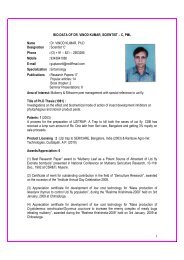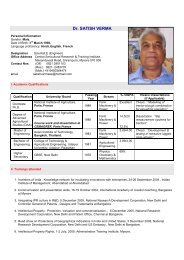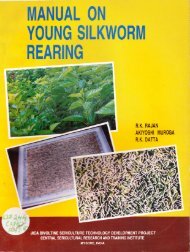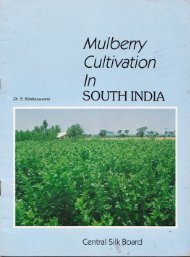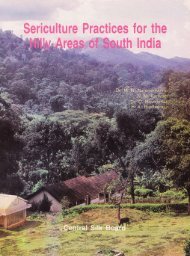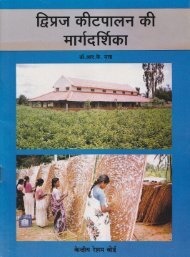OF
Economics of Sericulture under irrigated conditions - Central ...
Economics of Sericulture under irrigated conditions - Central ...
You also want an ePaper? Increase the reach of your titles
YUMPU automatically turns print PDFs into web optimized ePapers that Google loves.
SERICULTURE PROJECT N,I. 2<br />
(Reviserl-1986)<br />
ECONOMICS <strong>OF</strong> SERICULTURE<br />
UNDE,R IRRIGATED CONDITIONS<br />
DR. MANJEET S. JoLL\<br />
DIRECTOR<br />
CENTRAL SERICULTURAL RESEARCH AND<br />
TRAINING INSTITUTE<br />
(Central Silk Board-Ministry of Textiles-Govt. of India)<br />
MYSORE-570 008 (India)
SERICULTURE PROJECT NO. 2<br />
( Revised-1986 )<br />
ECONOMICS <strong>OF</strong> SERICULTURE<br />
IJNDER IRRIGATED CO}{DITIONS<br />
By<br />
Dr, t(anjeet 6, ]rffy<br />
DIRECTOR<br />
CENT-RAL SERICULTURAL RESEARCH AND<br />
TRAINING INSTITUTE<br />
(Central Silk Board-Ministry of Textiles-Govt. of India),<br />
MYSORE-57O 008 (India)
FORSWORD<br />
This project d,ocument was brought out in 1982. It was well received<br />
and the flrst print of 5000 copies became out of stock in 1984 itself. We<br />
are being pressed for this document from different spheres-technicians,<br />
sericologists, planners and administrators alike. This is a revised ddition<br />
incorporating the tecent research results in this field. A modest attempt<br />
has been made to bring out all practical details of "Economics of<br />
sericulture under irrigated, conditions."<br />
I sincerely hope that this revised edition will be welcomed by the<br />
readers and it will serve the purpose in the respective area of operation.<br />
Dr. Manjeet S. Jolly<br />
Director<br />
Central Sericultural Research &<br />
Training Tnsfifilte, Srirampuram,<br />
MYSORE-570 008, India
EONTENfS<br />
Introducfion<br />
Psrf I: Mulberry cultivation<br />
1. Selection of land<br />
2. Preparation of land<br />
3. Preparation of ridges and furrows<br />
4. Preparation of cuttings<br />
5. Spacing and planting<br />
6. Inter-culfivation<br />
7. Irrigation<br />
8. Manuring<br />
9. Pruning<br />
Part Il: Silkworm rearing<br />
1. Rearing house<br />
2. Crop pattern<br />
3. Preparation for brushing<br />
1. Incubation of eggs<br />
5. Brushing<br />
6. Young age silkworm rearing<br />
7. Quality and selection oi leaf<br />
8. Leaf prreservation<br />
9. Cleaning<br />
10. Moulting<br />
11. Late age silkworm rearing<br />
12. Mounting<br />
13. Harvest<br />
14. Economics<br />
i5. Annexures<br />
16. Illustrations<br />
Page<br />
I<br />
I<br />
1<br />
1<br />
2<br />
2<br />
J<br />
3<br />
3<br />
4<br />
4<br />
4<br />
5<br />
5<br />
6<br />
6<br />
7<br />
8<br />
8<br />
8<br />
8<br />
9<br />
9<br />
11<br />
t7
EcoNoMIcSoFSERICLILTUREUNDERIRRIGATEDcoNDITIoNS<br />
INTRODUCTION<br />
Nearly 50 per cent of the cost of cocoon production acc-ounts for raising the food<br />
plant, mulberry. Therefore, the productivify und^ th. profitability in sericulture depend<br />
mainly on maximisation of leaf yield, per unit ur"u ui reasonable cost' The intensive<br />
agronomic research carried out at central sericultural Research and Training Institute'<br />
dy;;;; has resulted in formulating the 'Package of Practices' for mulberry cultivation<br />
under irrigated conditi.ons. The technique tu'hich emphasise on the use of high yielding<br />
*rrit.r.V i-i.tv (Kanva-2), q stem of pLntation, adequate inputs like water and manures<br />
and proper cultural practices, have helped to increase theleaf yieldfrom 15,000 kgs to<br />
35,000 kgs per hectare per year. As a result, sericulture today has become one of the<br />
most rsmunerative .urt .rop, under irrigaied condition T!. mulberry cultivation<br />
under irrigation has increasedio nearly 50,000 hectares in South Indian Sericultural states<br />
alone, in the last six to eight years'<br />
while the recommendations of the "Package of Practices" have been no doubt<br />
helpful, information oo trr. organisational and management aspects for the farmefs'<br />
particularly the new entrants, to develop sericulture as a viable project, was lacking'<br />
economic hotding and efrcient management in sericulture are all the more important<br />
in the present context. The cost structure and profitability of establishing mulberry<br />
and raising cocoon "rofr,<br />
ur" discussed in this pup.t, in two parts, viz', Mulberry cultivation<br />
and Silkworm rearing.<br />
Part-I: MULBERRY CULTIVATION<br />
Mulberry is a perennial crop and once it is properly established during the first<br />
year, it can come to fit yielding capacity during the seaond year<br />
-and<br />
last for over 15 years<br />
without any si.gnificant deterioiation in leaf yield. It is, therefore, very important that<br />
the initial planting and establishment of tne crop is carried out according to scientific<br />
methods for obtaining best results in the subsequent years'<br />
1. Selection of land<br />
Muiberryisahardyplant.Itcouldbegrownonanytypeoflandandsoilbutaflat<br />
or slightly slopy land with red-sandy loam is ideal. The pH of the soil should be<br />
around 6.5. If the soil is acidic or alkaline, it should be corrected by addition of lime or<br />
*rn*- respectively. s*" -"ru.rry<br />
deep.<br />
is a deep rooted plant, the soil should be sufficiently<br />
2. PrepSratiol of f;riii<br />
.<br />
New plantation can be t4,ken up at any time under assured irrigation, except severe<br />
winter perioO in Decembet-Junruty.- Usually pre-monsoon shor'vers in April-Ir{'ay are
considered advantageous to start this operation. The land should be given a deep digging<br />
to a depth of 30 to 35 cm in order to loosen the soil and it should be plough.a o* ot<br />
twice to give a fine tilth. A basal dose of farm yard. manure at the rate oi 20 tonnes<br />
per hectare is applied and incorporated into the soil by ploughing.<br />
3. Preparation of ridges and furrows<br />
The prepared and levelled land is thror,vn into ridges and furro',vs alternately either<br />
by using a ridge former or manually. The furrows should be atleast 15 cm deep. The<br />
cuttings/saplings are later planted along the edges of the ridges on either side as shown<br />
in Fig. 1.<br />
2ID6F .G 60ca+<br />
IScm tocra<br />
(urrrNO<br />
A. Row system (60X22 cm) B. Pit system (60X60 cm)<br />
Fig. l. Formation of ridges and furrows and correct way of planting<br />
4. Preparation of cuttings<br />
Mulberry is propagated vegetatively through cuttings. Improved variety (Kanva-2)<br />
should be used for advantages on leaf yield aird quality. The branches which are 6<br />
to 8 months old and l0 to 12 mm in diameter are selected for cuttings. These are cut<br />
into bits of 18 to 20 cm length with a minimum ol3 to 4 healthy buds. The cut should<br />
be clean and should not damage the bark. The greenish tender portion of the branch<br />
should be rejected.<br />
5. Spacing and planting<br />
There are two systems of planting under irrigated condition. viz., the row system<br />
and the pit system. In the row system, the rows are made 60 cm apart and the cuitingsl<br />
saplings are planted in the row at a distance of 22 cm. In the pit systern, the rows<br />
"t.<br />
mu-dr<br />
60 cm apart and the cuttings/saplings are planted at a distance of 60 cm in the row.<br />
In case of row system, the leaf harvest is made by bottom pruning of shoots at a height<br />
of 7.5 cnt whereas in pit system harvesting is b1' leaf picking. The cuttings/saplings are<br />
2
planied along the margin of the ridges in the desired system and the soil around the<br />
cuttings/saplings is pressed compactly.<br />
6. fnter-cultivation<br />
Two months after planting, a light hoeing and weeding should be done. A second<br />
weeding is done after another 2 to 3 months. Thereafter, inter-cultivation should be done<br />
after every pruning or harvest. The weeding operation should be thorough and the soil<br />
should be dug deep to remove the rveeds with roots. This also results in loosening of the<br />
soil and stimulation to the plants to grorv vigorously.<br />
7. Irrigation<br />
The plantation taken up during the monsoon period have the advantage of receiving<br />
fairly distributed rains from June to November. If the rain is not adequate or fails for<br />
over 10 to 12 days, it should be supplemented with the required irrigation. During the<br />
dry period from December to May, systematic irrigation should be given regularly at an<br />
interval of 8 to 14 days depending on the type of soil. About t$ to 2 acre inches of water<br />
is required per irrigation, so that water fllls the channels completely and percolates deep<br />
and does not get depleted from the root zone easily due to evaporatioft. The correct<br />
method of irrigation is illustrated in Fig. 2.<br />
A. Shallow channel and superfical irrigation B. Proper size cbannel and deep irrigation<br />
Fig. 2. Correct way of irrlgation<br />
8. Manuring<br />
Under assured irrigation, the mulberry will grow vigorously and the first dose of<br />
fertiliser should be given after two and half months of planting, at the rate of 40 kg Nl
hectare. By sixth month, the plants would be ready for first harvest of leaves. Thereafter,<br />
the normal fertiliser application programme could be resorted to, following each<br />
harvest, at the rate of 300:120:120kg N:F:K per hectare per year in split doses (Annexure l).<br />
9. Pruning<br />
After 5-6 months of planting, mulberry attains a height of 2 metres and will be ready<br />
for first harvest of leaves. In row system, tire plants are iruned 2.5 to j.5 cm above the<br />
ground level. subsequent harvests are done at about l0 weeks interval.<br />
In the pit system, the first harvest of leaf is done after 5-6 months of planting.<br />
The well established plantations are pruned, twice a year, the first during early iune and<br />
the second in November at a height of 8-10 cm above the ground level. the first harvest<br />
after pruning will become due after 10 weeks and thereaiter subsequent harvests can be<br />
made at 6 to 8 weeks' interval depending on the growth. Iq all, six harvests can be taken<br />
in this system of cultivation.<br />
The new plantation<br />
-<br />
will be established in six months' time. In the first year itself,<br />
2 to 3 harvests can be taken, depending on the growth. From second year onwards,<br />
the plantation starts yielding to full capacity. The summary of schedule of operations<br />
for both row system and pit system ol piantations are given in Annexure 2 and 3. The<br />
cost of establishing one hectare of irrigated mulberry and maintaining the same are given,<br />
item wise, in Annexure 4.<br />
Part-II: SILKWORM REARING<br />
1. Rearing house<br />
A separate house is ideal for rearing of silkworms. The rearing house should<br />
have sufficient number of windows to permit cross ventilation. It should also be possible<br />
to make the rearing house airtight for proper disinfection. The design of a modeirearing<br />
house with a capacity to rear 1000 dfls at a time is given in Fig. 3.<br />
2. Crop pattern<br />
mulberry plantation is fully established in the first year and reaches maximum<br />
yield from 2nd year onwards. The leaf yield per crop is also more or less uniform throughout<br />
the year except the cold winter season.<br />
:urop Season Leaf yield/ha Rearing capacity<br />
No.<br />
____-__________ __ (ke) (JnO'<br />
1. August<br />
-F<br />
l$oo<br />
2. October-November 7,500 1,000<br />
3. January 6,000 800<br />
4. March-April 7,000 900<br />
5. June 7,000 900<br />
35,000 4,600
J<br />
l'<br />
l.<br />
I<br />
2O'x22.5 | etA2tve<br />
!<br />
----'n----<br />
H|LL<br />
I<br />
I,<br />
t got22.5<br />
I<br />
I<br />
cRos6 sEcntol, ou e e<br />
atao<br />
Dt DaOR t t.6 x6.6<br />
tt Htutofl ! tt +'<br />
E: EX?AIIDED ntTAl t 5tx1'<br />
PLTNTH /rRfA I tO.50 5?.A.<br />
scntE : t'L to'<br />
FAONT EL€YAT|ON<br />
Fig. 3. Design for rearing house to rear<br />
800-1000 layings at a time<br />
In the pit system, though the annual yield is comparable to that of row sy$tem,<br />
six crops could be taken by leafpicking instead of 5 in row system.<br />
Readng of 800 to 1000 dfls at a time is a bigger unit. It is advisable to split the<br />
mulberry garden into two units of $ hectare each, to facilitate rearing of 400 to 500 dfls<br />
at a time. However, two separate rearing units are necessary to avoid overlapping of<br />
batches and management problems. The design of the rearing house given in Fig. 3<br />
will suit this purpose.<br />
3. Preparation for brushing<br />
Before commencement of each rearing, the rearing equipments and the rearing<br />
house must be thoroughly washed, dried and disinfected with formalin. Two per cent<br />
to 4 per cent formalin is sprayed on equipments, walls, roof and floor uniformly to destroy<br />
the disease causing organisms. The room should be kept airtight for about 24 hours<br />
after disinfection. A quantity of 7 to 8 litres of 2 per cent formalin is required to disinfect<br />
100 m2 of area. The doors and windows should be kept open atleast for 24 hours<br />
before commencement of rearing to eliminate the smell of formalin.<br />
4. fncubation of eggs<br />
The disease free layings should be purchased from a recognised grainage. The<br />
egg sheets should be spread out in a single layer on atray. Temperature of 25"C and<br />
humidity around 80 per cent are maintained. For this, paraffin paper and wet foam pads<br />
may be used. When the eggs come to 'head pigmentation' stage, (about 48 hours before<br />
hatching) they should be kept in darkness by wrapping them in black paper or by keeping<br />
them in a box (black boxing). On the expected day of hatching, they are exposed to light<br />
early in the morning. Most of the eggs (90 to 95 per cent) will hatch in about 2-3 hours.
under the current practices, the rearers are supplied with silkworm eggs. It will<br />
be ideal to organise incubation in the grainage itself and supply the hatched worms to<br />
chawki rearing centres. The rearers should be given *orrnr'ihut are in III age. This<br />
will ensure scientific handring of the eggs and youig ug. .ilCor-r.<br />
5. Brushing<br />
The hatched larvae should not be starved and they must be brushed in a rearing<br />
tray with paraffin paper. .<br />
This is done by sprinkling tne fnoppeJ tender mulberry leaves<br />
of size 0.5 to I cm2 over the hatched raruie. The laivae<br />
"ruJ<br />
on to the leaves. After<br />
8 to l0 minutes, the egg sheet is inverted over rearing tray with farumo paper and gently<br />
tapped' worms that ate still attached to the egg sheets should Le gently removed to the<br />
tray with a feather' The rearing bed is prepared and some more chopped leaves, if necessary'<br />
are sprinkled' To prevent drying of leaves and maintain the requir.d'h;i;i;<br />
in the rearing bed, wet foam pads ani paraffin paper covering are provided (Fig. 4).<br />
The following description refers to the rearing of 400 dfls as a unit.<br />
A. Paraffin paper B. Ant weJl<br />
Fig. 4. Box rearing<br />
6, Young age silkworm rearing<br />
In a tray of 4' x3' x3$," size,20 disease free layings are brushed and reared tilr the<br />
end of second age. Temper-ature and humidity ,"qoir.ir.rri, tJ rpu"rrrg for every unit<br />
of 20 dfls for each day, number of feeds and quantity, creaning etc., are indicated<br />
in the following chart.<br />
6
Age of<br />
worms<br />
Days Temp. Humidity<br />
oc (%)<br />
1st<br />
Znd<br />
3rd<br />
4thl<br />
l27eo<br />
Bed spacing<br />
(20 dfls)<br />
9" xl2"<br />
18" xl2"<br />
18" x16"<br />
18" x24"<br />
No. of Qty. of Bed<br />
feedings/day leaflday (kg) cleaning<br />
4<br />
4<br />
4<br />
213<br />
0.200<br />
0.200<br />
0.240 r<br />
0.090 (Moult)<br />
il<br />
sthJ<br />
6th<br />
7th<br />
18" x24'<br />
24" x24"<br />
3O'x42"<br />
4<br />
4<br />
J<br />
0.400 I<br />
0.800 1<br />
0.450 (Moult)<br />
7. Quality anil selection of Ieaf<br />
From brushing to the end of second age, the larvae are fed with tender leaf. The<br />
leaves are selected from the largest glossy leaf, 3rd or 4th from the top. The next 6 to 8<br />
leaves are used to rear the young age worms upto II moult. The size of the chopped leaf<br />
is around 0.5 to I cm2 during the first age and I to 2 cm2 during 2nd age. The selection<br />
of leaf from a fully grown branch is illustrated in Fig. 5.<br />
8. Leaf preservation<br />
Silkworms grow best when fed with succulent leaves<br />
and moisture. The leaf, if not preserved properly, dries up<br />
which are rich in nutrients<br />
and become unsuitable for<br />
2N4 AGE<br />
7-ro<br />
3rJ<br />
,t-t5<br />
+fi, dgh<br />
,6A<br />
Fig. 5. Selection of leaf for rearing
feeding' Harvested leaves must be preserved in fresh condition in a wet gunny cloth.<br />
If the climate is too hot and dry, the leaves must be sprayed with water. rt is better to ,<br />
preserve leaves in a leaf chamber w'hich is lined with gunny cloth, that is kept wet by<br />
spraying water at frequent intervals.<br />
9. Cleaning<br />
.<br />
cleaning of silkworm bed is necessary to remove the excreta and left over leaf.<br />
In the first age, one cleaning is given just a day before the worms settle for moult. fn<br />
the second age, two cleanings are given, one afier resumption of feeding and the other a<br />
day before the second moult. A net with 'mesh' size 0.5 X0.5 cm is spread over the<br />
rearing bed and feeding is given' The worms crawl through the net and come to fresh<br />
Ieaves' The net along with the worms and leaves are transferred to another tray and the<br />
left-over leaf and litter are discarded.<br />
10. Moulting<br />
At the time of moulting, care should be talien not to disturb the worms. Correct<br />
detection of moult and stopping or resuming feeds are very important for uniform growth<br />
of silkworms. The rearing bed should be kept thin and dry and should haue lroper<br />
aeration.<br />
11. Late age silkworm rearing<br />
The silkworms of third, fourth and fifth ages are considered as late age worms.<br />
The temperature and humidily requirement gradually comes down as the stage uduuo""*.<br />
Leaves of medium maturity are fed in the third and iourth ug" uJ coarser leaves are fed<br />
in the fifth age. over matured and yellow leaves should be riected. A total quantity<br />
100 to of<br />
120 kg for 3 to days<br />
{<br />
in third age, 4o0 to 425 kg for + to s duy, in fourth age<br />
and 2,400 to 2,500 kgs for 6 to 7 days ;n finar age arc req:uired for rearing 400 dfls.<br />
worms<br />
The<br />
in the beginning of the third age should be kept in zo oumuoo round trays<br />
diameter<br />
of 3}/<br />
which is doubled gradually by the end of each age. The ,iit*o.* beds have<br />
cleaned<br />
to be<br />
three times during third age. During fourth and fifih ug"*, cleaning is done every day.<br />
Rearing schedule of the late age worms (for 400 Dfls)<br />
Factors Ut ug" ---- W-ug" V age<br />
Temperature<br />
* -]*^<br />
('C)<br />
26<br />
25<br />
24<br />
Humidity (f)<br />
80<br />
70-:/5<br />
10<br />
Period (days)<br />
3-4<br />
4-s<br />
6-7<br />
Size of leaf (cmz)<br />
4.0-6.0 Entire leaf/ Entire leaf/<br />
Totat quantity of leaf (kg)<br />
100_120 choPred shoots No. of<br />
,4ril3$0<br />
feeds per day<br />
No. of cteaniigs " \ uu, eu.f ouy<br />
Spacing (in ftzl<br />
180-360 "u"!, 360_7n 7zo-t440<br />
12. Mounting<br />
After attaining full growth in the final age, the worms cease to feed and are ready<br />
to spin. such worms are slightly translucent ind alss raise their heads to fi;t; il;;<br />
I
fors pinning. These worms have to be picked up and transferred to a mountage (chandrike)<br />
for spinning cocoons. Mounting of worms should not be delayed as the ripened worms<br />
will waste silk. About 40 to 45 worms per square foot are to be kept on a mountage.<br />
Thus around 1000 worms can be mounted in a 'chandrike' of 6'x4' size. For 400 dfls,<br />
about 120 'Chandrike' are required. Mountages should be kept in shadr' in a well ventilated<br />
place during spinning.<br />
13. Ilarvest<br />
The silkworms complete spinning in 48 to 72 hours but the cocoons should not be<br />
harvested at this time, as the rvorms inside are still soft in the pre-pupal stage. Harvesting<br />
should be done on the fifth day, rvhen pupae are fully formed and hard. Dead and diseased<br />
worms on the mountages should be removed before harvest. Marketing of cocoons<br />
should be done on the 6th dav.<br />
14. Economics<br />
During the first year of plantation only two crops can be taken with a rearing<br />
capacity of 650 to 700 dfls each. The plantation is fully established during the first year<br />
and reaches optimum productivity from second year onwards, with the leaf yield around<br />
35,000 kg/annum and rearing capacity ofabout 4600 dfls in five crops. The netprofitper<br />
hectare per year is about Rs. 15,173. The details of rearing expenditure and the economics<br />
are given below:<br />
_<br />
I*.rtr."t "" "q"tp..t<br />
Equipment<br />
1. Rearing trays (wooden) 20 trays @ Rs. 80 each<br />
(size 4'x3'x3!")<br />
2. Chawki rearing stand 2 Nos. @. Rs. 125 each<br />
3. Leaf chopping board 2 Nos. @ Rs. I2S each<br />
4. Chopping knives 2 Nos. @ ns. 20 each<br />
5. Antwells 64 Nos. @ Rs. 10 each<br />
6. Rearing stands 16 Nos. @ Rs. 350 each<br />
7. Bamboo round trays 3f' diameter 160 Nos. @<br />
Rs. 15 each<br />
8. Feeding stands 4 Nos. @ ns. 60 each<br />
9. Leaf chamber 5'x2$,x2$' 1 No. @ Rs. 250<br />
10. Sprayer I No. @ Rs. 620<br />
11. Hygrometer 1 No. @ Rs. 150<br />
12. Foam pads I kS @ Rs. 100 per kg.<br />
13. Silkworm bed cleaning nets 400 Nos. @ Rs. 3 each<br />
14. Bamboo mountages 120 Nos. @ Rs. 38 each<br />
Total<br />
Total Utility Value per<br />
cost (Rs.) (year) year (Rs.)<br />
1,600<br />
2s0<br />
zso<br />
40<br />
640<br />
5,600<br />
2,400<br />
24A<br />
250<br />
620<br />
1s0<br />
100<br />
1,200<br />
4,560<br />
17,900<br />
10<br />
10<br />
10<br />
J<br />
10<br />
l0<br />
10<br />
10<br />
10<br />
10<br />
4<br />
J<br />
160<br />
25<br />
25<br />
t3<br />
64<br />
s60<br />
800<br />
24<br />
25<br />
62<br />
15<br />
25<br />
400<br />
1,520<br />
3,718<br />
15. Building l046ft2 @ Rs. 5,000/100ftz<br />
52,300<br />
50 1,046
Expenditufe on redring for 400 dfls<br />
1. Cost ol 400 dfls<br />
(@ ns. 30 per 100 dfls)<br />
2. Cost of labour wages<br />
men per day: 36 Mandays<br />
Late age 12 days, 5 men per Oay: 60 l4andays<br />
Spinning and harvesting 2 days,<br />
8 men per day: 16 Mandays<br />
_Young age 12 days, ]<br />
Total:l 12 Mandays I<br />
@ R;<br />
per day/abourj<br />
3. Parafrn paper, formalin, newspaper, marketing of cocoon-etc.<br />
Total<br />
Returns<br />
Yield for 4,600 dfls @ of 35 kg cocoonsfor 100 dfls:1,619 j,<br />
and Marketing @ Rs. 3g per kg<br />
Rs,<br />
120<br />
Rs. 1,344<br />
Rs. 300<br />
Rs. 1,764<br />
Rs. 61,180<br />
Expenditure<br />
Non-recurring expenditure on rearing equipments<br />
(Rs. 3,7lgx2 units)<br />
Rearing expenditure for 4600 dfls<br />
@ Rs. 1764 for 400 dfls<br />
Leaf production (35,000 kg per year)<br />
(@ +s.Zs paise per/kg)<br />
Building value (Rs. 52,300+50)<br />
Net profit per hectare per year (2nd year onwards)<br />
Return through sale of cocoons<br />
Total expenditure<br />
Grand<br />
Rs. 7,436<br />
Rs. 20,286<br />
Rs. 17,239<br />
Total Rs. 44,961<br />
+ Rs. 7,046<br />
Total Rs. 46,007<br />
Rs. 61,180<br />
(-) Rs. 46,007<br />
)<br />
I<br />
Net profit Rs. 15,173<br />
10
ANNEXURE_I.<br />
Fertiliser schedule for irrigated mulberry<br />
Row system<br />
Pit system<br />
_<br />
lst application<br />
2nd application<br />
3rd application<br />
4th application<br />
5th application<br />
6th application<br />
60 kg N*60 kg'P*60 kg<br />
K as complex fertiliser<br />
60 kg N as straight fertiliser<br />
60 kg N*60 lig P*60 kg<br />
K as complex fertiliser<br />
60 kg N as straight fertiliser<br />
60 kg N as straight fertiliser<br />
60 kg N*60 kg P*60 kg<br />
K as complex fertiliser<br />
40 kg N as straight fertiliser<br />
40 kg N as straight fertiliser<br />
60 kg N*60 kg P*60 kg<br />
K as complex fertiliser<br />
40 kg N as straight fertiliser<br />
40 kg N as straight fertiliser<br />
Total<br />
300 ke N+120 kg P*120 kg K 280 kg N+120 kg pf 120 kg K<br />
l1
ANNEXURE_2.<br />
schedule of operations for irrigated murberry (Row system-60 cm xz2 cm)<br />
Operations<br />
Timings<br />
1.<br />
,<br />
4.<br />
6.<br />
7.<br />
8.<br />
lst pruning combining harvest<br />
lst weeding and inter-cultivation<br />
Application of bulky organic manure<br />
at the rate of 20 tonnes per hectare<br />
and incorporation of the same<br />
lst dose of fertiliser application<br />
1st harvest of leaves<br />
2nd weeding and inter-cultivation<br />
2nd dose of fertiliser application<br />
2nd harvest of leaves<br />
With the commencement of south west<br />
monsoon rains (early June)<br />
Within a week after pruning (2nd week of<br />
June)<br />
Within a fortnight after pruning (mid-June)<br />
Within a month after pruning (early July)<br />
By pruning (mid August)<br />
Within a n'eek of last harvest (2nd week of<br />
August)<br />
\Yithin a month of last harvest (rnid<br />
September)<br />
By pruning (early November)<br />
9. 3rd weeding and inter-cultivation Within a week of last harvest (2nd week of<br />
10. 3rd dose of fertiliser application<br />
November)<br />
Within a month of last harvest (early<br />
December)<br />
11. 3rd harvest of leaves<br />
12. 4th weeding and inter.-cultivation<br />
13. 4th dose of fertiliser application<br />
14. 4th harvest of leaves<br />
15. 5th weeding and inter-cultivation<br />
t6. 5th dose of fertiliser application<br />
17. 5th harvest of leaves<br />
By pruning (mid January)<br />
Wjthin a week of last harvest (3rd week of<br />
January)<br />
Within a month of last harvest (mid<br />
February)<br />
By pruning (late March)<br />
Within a week of last harvest (lst week of<br />
April)<br />
Within a month of last harvest (late April)<br />
By pruning (early June)<br />
Following the above schedule of operations, leaf yietd of 35,000 kg/haTannum is<br />
obtained.<br />
t2
ANNEXURE-3.<br />
Scheilule of operations for irrigaterl mulberry (Pit system-60 cm x 60 cno)<br />
Operations<br />
Timings<br />
1. lst bottom pruning With the cofilmencement of south-west<br />
monsoon rains (early June)<br />
2,. lst weeding and inter-cultivation Withinra week after pruning (2nd week of<br />
3. Application of bulky organic manure Within a fortnight after pruning (3rd week<br />
at the rate of 20 tonnes per hectare of June)<br />
and incorporation of the same<br />
4. lst dose of fertiliser application Within a month after pruning (earb July)<br />
5. lst harvest of leaves By leaf picking (mid August)<br />
6. 2nd weeding and inter-cultivation Within a week of last harvdst (3rd week of<br />
August)<br />
7. 2nd dose of fertiliser application **::l :Tnffii:nof<br />
last harvest (2nd<br />
8. 2nd harvest of leaves By leaf picking (early October)<br />
9. 3rd dose of fertiliser application Within three weeks of last harvest (4th<br />
week of October)<br />
10. 3rd harvest of leaves By leaf picking (late November)<br />
11. 2nd bottom pruning fmmediately after 3rd leaf harvest (late<br />
November)<br />
12. 3rd weeding and inter-cultivation Within a week after 2td pruning (first week<br />
of December)<br />
13. 4th dose of fertiliser application Within a month after 2nd pruning (3rd<br />
rveek of December)<br />
14. 4th harvest of leaves By leaf picking (early February)<br />
15. 5th dose of lertiliser application Within 3 weeks after last harvest (4th week<br />
of February)<br />
16. 5th harvest of leaves By leaf picking (first week of April)<br />
17. 4th weeding and inter-cultivation Within a week after last harvest (second<br />
week of April)<br />
18. 6th dose of fertiliser application Within 3 weeks after last harvest (late April)<br />
19. 6th harvest of leaves By leaf Picking (late May)<br />
Following the above schedule of operations, leaf yield of 35,000 kg/ha/annum is<br />
obtained.<br />
13
ANNEXURE*a (a)<br />
Econonics of mulberry cultivation_First year<br />
cost of cuitivation or one hectare of murberry under irrigated condition,<br />
-Plantation and estabrishmen* cost lnon-."cuo.ing), row *irt., (60 cm x 22cm)<br />
Operations<br />
* i<br />
t. Deep ploughing by mould -l*-*<br />
j Requirements<br />
board plough (Tractor power) i fO n,<br />
Disc harrowing (Tractor po*..] I 6 h,<br />
I<br />
(Bullock power) j tO pairs<br />
Farm yard manure<br />
Application of farm yard<br />
manure<br />
20 Mandaysl<br />
Planting material<br />
fO .urt fouirl<br />
Preparationolcuttings(i,10,000) Ptgnaratinn nfcrrffin^o /r r n nnnr +S trtanaavs]<br />
Rate (Rs.)<br />
Amount<br />
(Rs.)<br />
2 i il;il;;;;"';:.":":::.::{ I 'y y I e0 per hour I eoo-oo<br />
3 jF;"i;;;;;;,:;':;'";:5*"'I o* l eOperhour<br />
Final preparation<br />
j s+o-oo<br />
of land '<br />
4. I i;;;;;";;;,,'^ i ju natrs<br />
] i 20 per pair zo r0 i"""", tonnes<br />
J zoo-oo<br />
s. I ;;;r";;^;;;:: .,^-, J<br />
100 per tonne I z,ooo+o<br />
6. I pr""ii"" rnateriat :: -llou{ti 1-2 per Mandav I z+o-oo<br />
7. f pr"""*?,"""i"i**,.^./r rn nnnr lu cart loadsi 50 per cart Ioad j sOO_OO<br />
12 per<br />
8.<br />
Manday i S+O+O<br />
-? / rr"*rg Making 'rs-vJ ridges s'u and rurruws lurrows z: 25 Mandaysl<br />
Planting<br />
M;;;;;l 12 per<br />
r rcrrLruB<br />
Manday I<br />
3-00-00<br />
I j<br />
i0. i H;i;;"""d 50 sn<br />
rveerrino /{ ri*^.\ ,".<br />
Mandavsi rr.-,r^_.^l<br />
Y1o9u''t, ]?ptt<br />
Mandav j ooo-oo<br />
3:.i1_-n and r.veeding (5 times) i '<br />
rZs U""J"i,rl<br />
tr. i il;;li;;, *..i,rj. ttures/ tr) MandaYs' 12 per Mandav<br />
Miscellaneous expenditures<br />
i _- i ,,:99-99<br />
rj<br />
i 130-oo<br />
li<br />
I , i<br />
l7'4so-oo<br />
This is the initial expenditure for planting. The garden is expected to give consistantly<br />
good yield for a period of 15 years. ' s" ;; cost has to be divioed over a period of<br />
15 years as non-recurring<br />
""p.nditurr_nr.-+SZ.<br />
Continued on next page<br />
11
SI.<br />
No.<br />
Operations Requirements Rate (Rs.)<br />
Amount<br />
(Rs.)<br />
12.<br />
Digging, weeding and mrking<br />
ridgee and furrows<br />
3 times a<br />
year-300<br />
Mandays<br />
121- per Manday<br />
3,600-o0<br />
tr- Irrigation<br />
loo kgN: 50kgp: 50kgK<br />
l(i) supnata<br />
14. lrorilir",<br />
1,,,, u,.u<br />
15. jennri."tioo of fertilizer<br />
25 times<br />
a year-200<br />
Mandays<br />
333 kg<br />
111 kg<br />
12 Mandays<br />
,t<br />
@ Rs. 1,900/-<br />
per tonne<br />
@ Rs. 2,i05/-<br />
per tonne<br />
l2l- per Manday<br />
2,400-o0<br />
633-O1)<br />
234-O0<br />
144-{0<br />
16.<br />
lllarvcsting<br />
oF I2,0m* kg leaf<br />
I<br />
50 kg leafl<br />
day/labour*<br />
80 Manday<br />
121. per fuIanday<br />
960-O0<br />
17.<br />
18.<br />
i "{tu*"rr,ng oi 4,oookg of leaf by<br />
plucking rtrdt[od and 8,000 kg<br />
of leaf by shoot harvest method)<br />
Non-recurring<br />
Land revenue<br />
125 kg leaf<br />
per labbur in<br />
the form of<br />
shoot or<br />
250 kg shoot/<br />
labour-<br />
64 Mandays<br />
l2l- pet Manday<br />
768-00<br />
497-.00<br />
20-00<br />
15
ANNEXURE_4 (b)<br />
Cultivafion expenditure from 2nd year onwards<br />
6.<br />
7.<br />
2.<br />
+.<br />
5.<br />
I<br />
I<br />
3j*j'"g, l':di;;; *,kt,1c<br />
rrcges and fuffows<br />
I Irri<br />
rrrgatl( rga ;ation<br />
i nu. iarm n yard y manure<br />
Apl pplica ,plir licationr of farm yard<br />
maI Ianuar( nut Iale<br />
Fert ertilize 'tili: lizers ( 300 kg N:120<br />
120 l0 kg (c<br />
kg p<br />
K)<br />
(;)) Sutr s Suph rphala<br />
(it I<br />
Ur<br />
hea<br />
Application of fertilizers<br />
Harvesting of 35,000 kg leaf<br />
(If leaf picking js done 700<br />
man days required, costing<br />
Rs. 8,400/-)<br />
Non-recuring<br />
Land revenue<br />
Leaf yield 35,000 kglha.<br />
uost ot-production ofl,one kg of<br />
leaf 49.25 paise<br />
Requirements<br />
f sum.ru<br />
I<br />
year 500<br />
Mandays<br />
25 times-<br />
200 Mandays<br />
20 tonnes<br />
20 l4andays<br />
800 kg<br />
400 kg<br />
30 Mandays<br />
125 kg teafl<br />
DaylLabour<br />
or 250 kg<br />
shootlDayl<br />
Labour-2g0<br />
Mandays<br />
I<br />
l<br />
I<br />
I<br />
I<br />
/<br />
I<br />
Rate (Rs.) |<br />
I<br />
Amount<br />
(Rs.)<br />
l2lperManday I<br />
l2lper Mandav I<br />
100/per tonne ' /<br />
l2lper Manday<br />
@ Rs. 1,900/-<br />
i<br />
per tonne I t<br />
O Rs. 2,105/-<br />
/<br />
per tonne I<br />
121 perfrtuoOu, f<br />
l2l- per Manday<br />
6,000-00<br />
2,400_00<br />
2,000-00<br />
240_0a<br />
3,360_00<br />
497-00<br />
20-00<br />
/----_-<br />
I n,zze-oo<br />
i---*<br />
I<br />
I<br />
I<br />
I<br />
,520-o0<br />
842-00<br />
360*00<br />
I<br />
16
RXARING EQUIPMENTS<br />
GEEOlrao S taxo (weoa..l<br />
r7
laii*C<br />
B"aw aE*od<br />
Cl/nflDR/K/t<br />
+',at<br />
t<br />
LFA. c!&Ezi<br />
(*oaoet)<br />
18
IAilAOO tFAV (nound,<br />
O+l |G6OaS (uoott)<br />
3'<br />
19




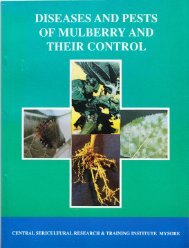

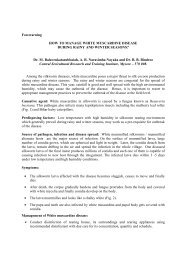
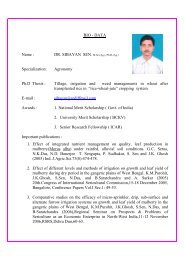
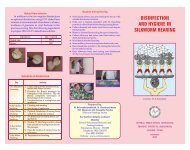
![E}A]\GALORE](https://img.yumpu.com/54052619/1/190x260/eagalore.jpg?quality=85)

